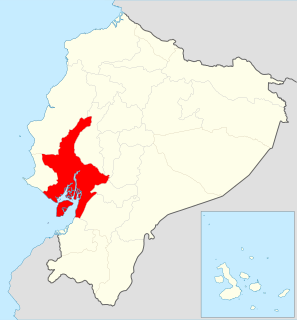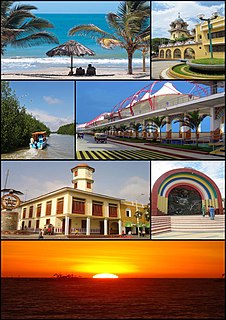
Ecuador, officially the Republic of Ecuador, is a country in northwestern South America, bordered by Colombia on the north, Peru on the east and south, and the Pacific Ocean on the west. Ecuador also includes the Galápagos Islands in the Pacific, about 1,000 kilometres (621 mi) west of the mainland. The capital is Quito.

Ecuador is a country in western South America, bordering the Pacific Ocean at the Equator, for which the country is named. Ecuador encompasses a wide range of natural formations and climates, from the desert-like southern coast to the snowcapped peaks of the Andes mountain range to the plains of the Amazon Basin. Cotopaxi in Ecuador is one of the world's highest active volcanos. It also has a large series of rivers that follow the southern border and spill into the northwest area of Peru.
Transportation in Ecuador can be summarized in the following areas: aviation, highways, pipelines, ports and harbors, railways, and waterways. Apart from transporting passengers, the country is a relatively small exporter of, alongside fruits and vegetables such as Banana's, Papaya's and Pineapples.

Guayaquil, officially Santiago de Guayaquil, is the largest city of Ecuador. It is also the nation's main port. The city is the capital of Guayas Province and the seat of Guayaquil canton.

Guayas is a coastal province in Ecuador. It is bordered to the west by Manabí, Santa Elena, and the Pacific Ocean ; to the east by Los Ríos, Bolívar, Chimborazo, Cañar, and Azuay; to the north by Los Ríos and Bolívar; and to the south by El Oro and the Pacific Ocean.

Tumbes is a city in northwestern Peru, on the banks of the Tumbes River. It is the capital of the Tumbes Region, as well as of Tumbes Province and Tumbes District. Located near the border with Ecuador, Tumbes has 111,595 inhabitants as of 2015. It is served by the Cap. FAP Pedro Canga Rodriguez Airport. It is located on the Gulf of Guayaquil along with Zorritos.

The Guayas River also called Rio Guayas is a major river in western Ecuador. It gives name to Guayas Province and is the most important river in South America that does not flow into the Atlantic Ocean or any of its marginal seas. Its total length, including the Daule River, is 389 km (241 mi). The Guayas River's drainage basin is 34,500 sq.km and it has an average discharge of 70,000 cu ft/s. It is the national river of Ecuador and is present on the Coat of Arms.

Puná Island is an island off the coast of southern Ecuador at approximately 80 degrees west longitude and 3 degrees south latitude. It is located at the head of the Gulf of Guayaquil, south of the mouth of the Guayas River and the city of Guayaquil, Ecuador's largest city and chief port. It is bordered by Jambelí Channel on the east and Morro Channel on the west, both of which connect the open Gulf of Guayaquil to the narrow mouth of the Guayas River. The total area of Puná Island is 330 square miles. The island is a parish of Guayaquil Canton in Guayas Province.

The Zarumilla River is a river in South America that marks the border between Peru and Ecuador. It is named after the Peruvian town of Zarumilla.

The Tumbes River, is a river in South America.

The Gulf of Guayaquil–Tumbes mangroves (NT1413) are an ecoregion located in the Gulf of Guayaquil in South America, in northern Peru and southern Ecuador. It has an area of 3,300 km².

The territorial dispute between Ecuador and Peru was the source of a long period of intermittent armed conflict between the two countries. This dispute was a consequence of each country's interpretation of what Real Cedulas Spain used to precisely define its colonial territories in the Americas. After independence, all of Spain's colonial territories signed and agreed to proclaim their limits in the basis of the principle uti possidetis juris which accepts the Spanish colonial borders of 1810 as the borders of the new republics. Thus the borders of Gran Colombia which included Ecuador, Colombia and Venezuela would follow the borders of the Viceroyalty of New Granada, and Peru the Viceroyalty of Peru in 1810. However, Peru was not satisfied with this and tried to set the date of her Uti Possitedis to 1824 – a time when Peru was officially independent with territories Peru militarily occupied since 1820.

The Guayaquil squirrel is a tree squirrel endemic to Ecuador and Peru. It is a robust squirrel with a head-and-body length of 18 to 32 cm and a similar length tail. The colour is variable; in Peru, a pale morph is more common, while in Ecuador, most individuals have darker grey fur on the forequarters, dull orange hindquarters. A melanistic morph is sometimes seen. It lives largely in trees and is diurnal, feeding on seeds, flowers, and other plant material, fungi and some insects. These squirrels are also found in urban areas, living in close proximity to humans, and may be vectors for leptospirosis and Chagas disease. This squirrel faces no particular threats, has a wide range and is relatively common, and the International Union for Conservation of Nature has rated it as being of "least concern".

The following is an alphabetical list of topics related to the Republic of Ecuador.

The Battle of Guayaquil was the final and pivotal armed confrontation of the Ecuadorian Civil War. The battle was fought on the outskirts of the city of Guayaquil, Ecuador on September 22 – 24, 1860 among several factions claiming control of the country's territory in the wake of the abdication of president Francisco Robles, amidst continuous Peruvian military pressure due to an ongoing war. The battle brought an end to a series of skirmishes between the forces of Gabriel García Moreno's Provisional Government, backed by General Juan José Flores, and the government of General Guillermo Franco in Guayas, which was recognized by Peruvian president Ramón Castilla.

Pedro Carbo Canton is a land-locked coastal canton located in Guayas Province in Ecuador, near Manabí Province. Its capital is the town of Pedro Carbo. It is located at the 63 kilometer marker on the road from Guayaquil to Manabí. It is the seat of Pedro Carbo Cantón, founded in 1984. As of the census of 2001, there are 36,711 people residing within canton limits. A new census was conducted in 2010 but results are yet unknown. The city is named after Pedro Carbo Noboa, a 19th-century politician, diplomat and writer from Guayaquil.

The 1949 Ambato earthquake was the largest earthquake in the Western Hemisphere in more than five years. On August 5, 1949, it struck Ecuador's Tungurahua Province southeast of its capital Ambato and killed 5,050 people. Measuring 6.4 on the scale, it originated from a hypocenter 15 km beneath the surface. The nearby villages of Guano, Patate, Pelileo, and Pillaro were destroyed, and the city of Ambato suffered heavy damage. The earthquake flattened buildings and subsequent landslides caused damage throughout the Tungurahua, Chimborazo, and Cotopaxi Provinces. It disrupted water mains and communication lines and opened a fissure into which the small town of Libertad sank. Moderate shaking from the event extended as far away as Quito and Guayaquil.

The 1797 Riobamba earthquake occurred at 12:30 UTC on 4 February. It devastated the city of Riobamba and many other cities in the Interandean valley, causing between 6,000–40,000 casualties. It is estimated that seismic intensities in the epicentral area reached at least XI (Extreme) on the Mercalli intensity scale, and that the earthquake had a magnitude of 8.3, the most powerful historical event known in Ecuador. The earthquake was studied by Prussian geographer Alexander von Humboldt, when he visited the area in 1801–1802.

The 1953 Tumbes earthquake occurred on December 12 at near the border between Peru and Ecuador. The shock had a moment magnitude of 7.5, a maximum Mercalli Intensity of VIII (Severe), and occurred in the northwestern offshore area of Tumbes, Peru.

The 1942 Ecuador earthquake which occurred on 13 May at 9:13 pm ECT with a moment magnitude of 7.8 struck the coastal regions of Ecuador, causing damage mainly to cities like Guayaquil, Portoviejo and Guaranda. An estimated 200 people lost their lives and the total damage cost about US$2.5 million as a result.
















